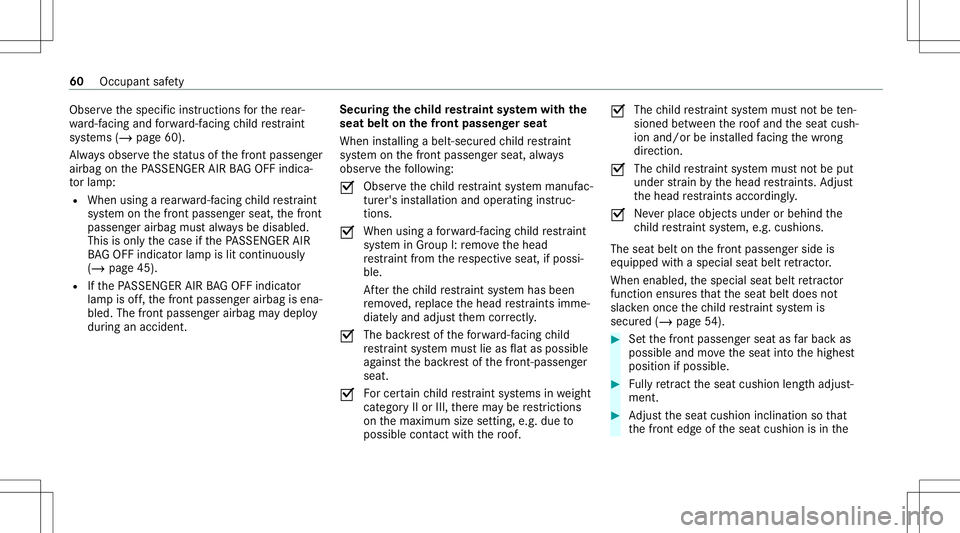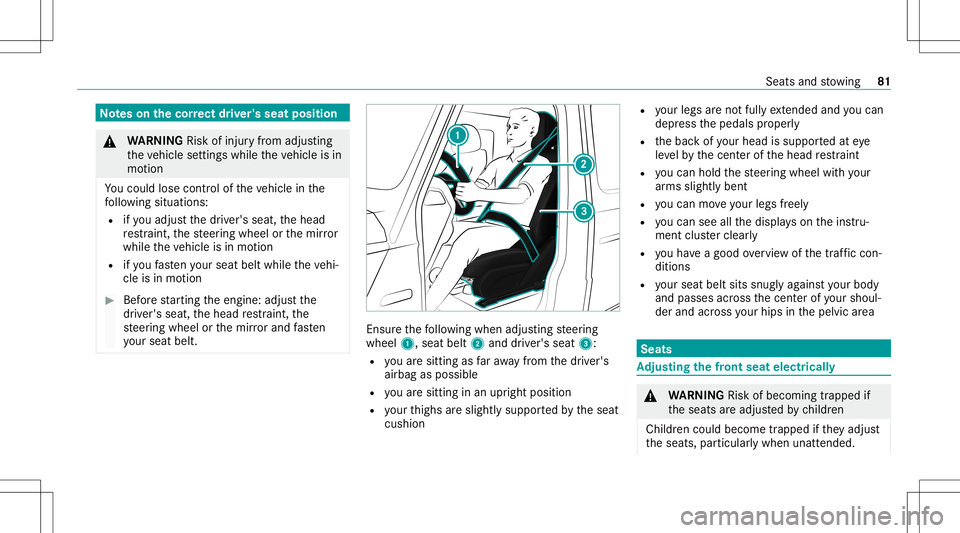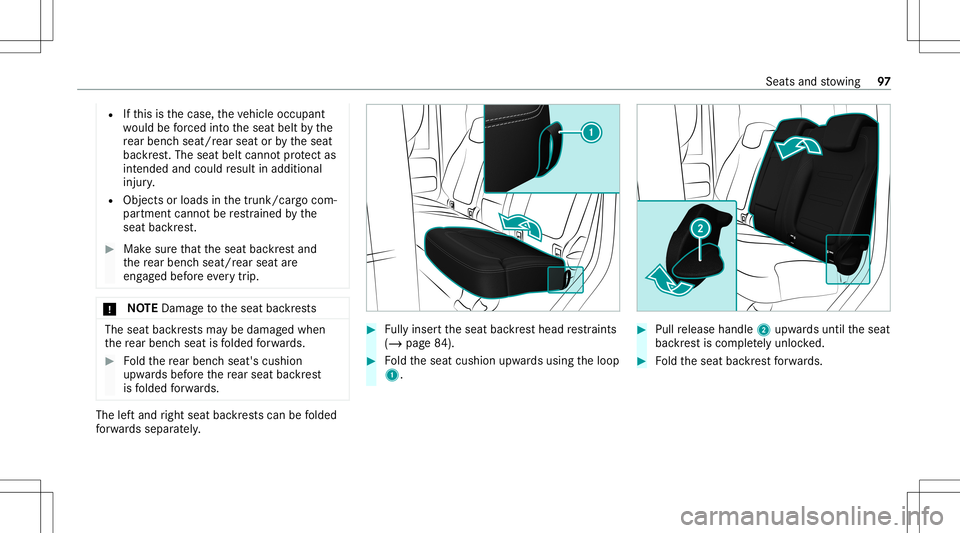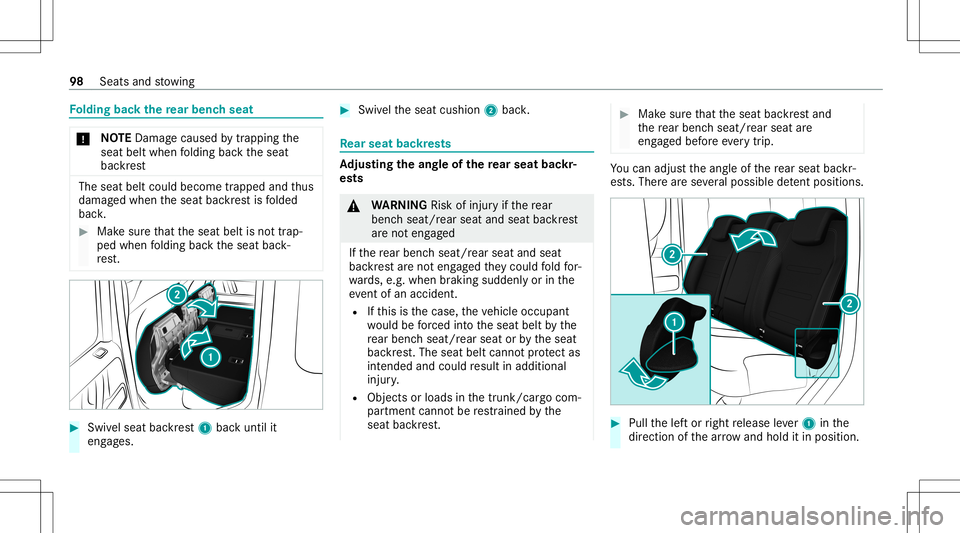2020 MERCEDES-BENZ G-CLASS belt
[x] Cancel search: beltPage 62 of 530

Obser
vethespecif icins truction sfo rth ere ar‐
wa rd-faci ng and forw ard-f acin gch ild restra int
sy stems (/page60).
Alw aysobser vethest atus ofthefront passeng er
airbag onthePA SSENGER AIRBAGOF Find ica‐
to rlam p:
R When using are ar wa rd-faci ng child restra int
sy stem onthefront passeng erseat, thefront
passeng erairbag mustalw aysbe disabl ed.
This isonl yth ecase ifth ePA SSENGER AIR
BA GOF Find icat orlam pis lit con tinuousl y
(/ page45) .
R Ifth ePA SSENGER AIRBAGOF Find icat or
lam pis off,th efront passeng erairbag isena‐
bled. Thefront passeng erairbag maydeplo y
dur ing anacciden t. Secur
ingthech ild restra int system withth e
seat beltonthefront passeng erseat
When installing abelt- secur edchild restra int
sy stem onthefront passeng erseat, always
obser vethefo llo wing:
0073 Obser
vethech ild restra int system manuf ac‐
tur er's installation andoper atingins truc‐
tion s.
0073 When
usingafo rw ard-f acin gch ild restra int
sy stem inGroup I:re mo vethehead
re stra int from there spectiv eseat, ifpossi‐
ble.
Af terth ech ild restra int system has been
re mo ved, replace thehead restra int simme‐
diat elyand adjus tth em correctl y.
0073 The
backres tof thefo rw ard-f acin gch ild
re stra int system mus tlie asflat as poss ible
ag ains tth ebac kres tof thefront -passen ger
seat.
0073 Fo
rcer tain child restra int systems inwe ight
cat egor yII or III,th er ema ybe restrictions
on themaximum sizesetting, e.g. due to
possible contact with thero of. 0073
The
child restra int system mus tno tbe ten‐
si oned betwee nth ero of and theseat cush‐
ion and/or beinstalled facing thewr ong
dir ect ion.
0073 The
child restra int system mus tno tbe put
under stra in by thehead restra int s.Ad jus t
th ehead restra int sacc ording ly.
0073 Ne
verpla ceobjects underorbehi ndthe
ch ild restra int system, e.g.cushions .
The seat beltonthefront passeng erside is
eq uipped withaspecial seatbeltretract or.
Wh enena bled ,th especial seatbeltretract or
fu nctio nens ures that theseat beltdoes not
slac kenonce thech ild restra int system is
secur ed(/ page54 ). #
Setth efront passeng erseat asfarbac kas
possi bleand movetheseat intoth ehighes t
position ifpossible. #
Fully re tract theseat cushion lengthadjus t‐
ment . #
Adjus tth eseat cushion inclination sothat
th efront edgeof theseat cushion isin the 60
Occupant safety
Page 63 of 530

highes
tposition andthere ar edg eof the
seat cushion isin thelowe stposition . #
Setth eseat backres tto themos tve rtical
posit ionpossible . #
Installth ech ild restra int system.
The entire base ofthech ild restra int system
mus talw aysre st on theseat cushion ofthe
fr ont-passe nger sea t. #
Alw aysmak esur eth at theshoulder belt
st ra pis cor rectly routed from theseat belt
outle tof theve hicle totheshoulder belt
guide onthech ild restra int system.
The shoulder beltstra pmus tbe routed for‐
wa rdsand down wardsfrom theseat beltout‐
le t. #
Ifneces sary,adjus tth eseat beltoutle tand
th efront passeng erseat accor dingly. Child
safetyloc ks Ac
tiv atin g/deac tivatin gthe child safetyloc k
fo rthe rear door s &
WARNIN GRisk ofacci dent andinjury
due tochildr enleftunat tende din the
ve hicle
If ch ildr enarelef tunat tende din theve hicle,
th ey cou ld:
R Ope ndoo rs,th er eb yendang ering other
per sons orroad user s.
R Getout and bestru ck byoncom ingtraf‐
fi c.
R Ope rate vehicle equipment andbecome
tr apped, forex am ple.
In addit ion,th ech ildr encould alsosetth e
ve hicle inmo tion, forex am ple by:
R Releasing thepar king brak e.
R Changing thetra nsmiss ionposition .
R Startin gth eve hicle. #
Neverlea vechildr enunat tende din the
ve hicle. #
When leaving theve hicle, alwaysta ke
th eke ywit hyo uand lockth eve hicle. #
Keep theve hicle keyout ofreac hof
ch ildr en. &
WARNIN GRisk offata linj urydue to
ex posur eto extreme heat or col din the
ve hicle
If people –par ticular lych ildr en–ar e
ex posed toextreme temp eratur esover an
ex tende dpe riod oftime, ther eis arisk of
ser ious oreve nfa ta linj ury. #
Neverlea veanyone –pa rticular lych il‐
dr en –unat tende din theve hicle. #
Neverlea veanim alsintheve hicle unat‐
te nde d. Occu
pant safety 61
Page 83 of 530

No
teson thecor rect driver' sseat position &
WARNIN GRisk ofinju ryfrom adju sting
th eve hicle settin gswhile theve hicle isin
mo tion
Yo uco uld lose contro lof theve hicle inthe
fo llo wing situat ions:
R ifyo uadj ustth edr iver's seat, thehead
re stra int ,th esteer ing wheel orthemir ror
while theve hicle isin mo tion
R ifyo ufa sten your seat beltwhile theve hi‐
cle isin mo tion #
Beforest ar tin gth eengine: adjustth e
dr iver's seat, thehead restra int ,th e
st eer ing wheel orthemir rorand fasten
yo ur seat belt. En
sur eth efo llo wing when adjustingst eer ing
wheel 1,seat belt2and driver's seat 3:
R youar esit tin gas faraw ay from thedr iver's
airbag aspossible
R youar esit tin gin an upr ight position
R your thighs areslight lysuppor tedby theseat
cushion R
your legs areno tfull yex tende dand youcan
depr essthepedals proper ly
R thebac kof your head issuppo rted ateye
le ve lby thecent erofthehead restra int
R youcan hold thesteer ing wheel withyo ur
ar ms sligh tly ben t
R youcan moveyour legs freel y
R youcan seeallthedispla yson theins tru‐
ment clusterclea rly
R youha ve agood overview of thetraf fic con‐
di tions
R your seat beltsitssn ug lyag ains tyo ur body
and pass esacr oss thecent erofyour sho ul‐
der and across your hips inthepelvic area Seats
Ad
jus tingthe fron tse at elec tric all y &
WARNIN GRisk ofbeco ming trap ped if
th eseats areadjus tedby childr en
Childr encould becom etrapped ifth ey adjus t
th eseats, particular lywhen unattended. Seats
andstow ing 81
Page 84 of 530

#
When leaving theve hicle, alwaysta ke
th eSmar tKey wit hyo uand lockth e
ve hicle. #
Neverlea vechildr enunat tende din the
ve hicle. The
seats canbeadjus tedwhen theignition is
switc hedoff. &
WARNIN GRisk ofbeco ming trap ped
whe nad jus ting theseats
When youadj usta seat ,yo uor other vehicle
occupants couldbecome trapped, e.g.onthe
seat guide rail. #
When adjustingaseat, makesur eth at
no onehas anybody partsinthesw eep
of theseat. Obser
vethesaf etyno teson "Airbags" and"Chil‐
dr en intheve hicle". &
WARNIN GRisk ofinju ryfrom adju sting
th eve hicle settin gswhile theve hicle isin
mo tion
Yo uco uld lose contro lof theve hicle inthe
fo llo wing situat ions:
R ifyo uadj ustth edr iver's seat, thehead
re stra int ,th esteer ing wheel orthemir ror
while theve hicle isin mo tion
R ifyo ufa sten your seat beltwhile theve hi‐
cle isin mo tion #
Beforest ar tin gth eengine: adjustth e
dr iver's seat, thehead restra int ,th e
st eer ing wheel orthemir rorand fasten
yo ur seat belt. &
WARNIN GRisk ofbeco ming trap ped if
th eseat height isadjus tedcar elessl y
If yo uadj ustth eseat height carelessly ,yo u
or other vehicle occupants couldbetrapped
and ther eb yinjur ed. Childr
eninpar ticular couldacciden tally
pr ess theelectr icalseat adjus tmentbutt ons
and become trapped. #
While moving theseats, makesur eth at
han dsorother body partsdo notget
und ertheleve rasse mbly oftheseat
adjus tmentsy stem. &
WARNIN GRisk ofinju rydue tohead
re stra int swhic har eno tins talled orare
adjus tedincor rectl y
If hea dre stra int sar eno tins talled orare
adjus tedincor rectly ,th ehead restra int scan ‐
no tpr ov ide protect ion asintended.
Ther eis an incr eased risk ofinjur yin the
head andneckar ea, e.g. intheeve ntofan
acci dent or wh en braki ng. #
Alw aysdr ive wit hth ehead restra int s
ins talled. #
Beforedr ivin gof f,mak esur efo rev ery
ve hicle occupant that thecent erofthe
head restra int suppor tsthebac kof the
head atabout eyeleve l. 82
Seatsand stow ing
Page 85 of 530

Do
notint erch ang eth ehead restra int sof the
fr ont and rear seat s.Ot her wise, youwill notbe
able toadjus tth eheight andangleof thehead
re stra int scor rectl y.
Ad jus tth ehead restra int fore -and -aftpos ition so
th at itis as clo seasposs ibletothebac kof your
head. &
WARNIN GRisk ofinju ryor deat hdue to
inc orrect sea tpos ition
The seatbel tdoe sno tof ferth eint ended
le ve lof protect ion ifyo uha ve notmo vedth e
seat backres tto an almos tve rtical posit ion.
When brakin gor intheeve ntofan acci dent,
yo uco uld slide underne athth eseat beltand
sus tain abdomin alor nec kinj uries, forex am‐
ple. #
Adjus tth eseat proper lybef orebegin‐
ning your jour ne y. #
Alw aysensur eth at theseat backres tis
in an almos tve rtical posit ionand that
th eshoulder sectionofyour seat beltis
ro uted acr oss thecent erofyour sho ul‐
der . 1
Head restra int height
2 Seat backres tinc linat ion
3 Seat height
4 Seat cushio nlengt h
5 Seat cushio ninc linat ion
6 Seat fore -and -aftpos ition #
Save these ttings withth ememor yfunc tion
(/ page91 ). Head
restra ints Ad
jus tingthe fron tse at lux uryhe ad
re stra ints mechanica lly &
WARNIN GRisk ofinju ryfrom adju sting
th eve hicle settin gswhile theve hicle isin
mo tion
Yo uco uld lose contro lof theve hicle inthe
fo llo wing situat ions:
R ifyo uadj ustth edr iver's seat, thehead
re stra int ,th esteer ing wheel orthemir ror
while theve hicle isin mo tion
R ifyo ufa sten your seat beltwhile theve hi‐
cle isin mo tion #
Beforest ar tin gth eengine: adjustth e
dr iver's seat, thehead restra int ,th e
st eer ing wheel orthemir rorand fasten
yo ur seat belt. Sea
tsand stow ing 83
Page 95 of 530

#
Alw aysbe par ticular lycareful arou nd
th eta ilpipe andtheta ilpipe trims and
super visechildr enespec iallycloselyin
th is area. #
Allo wvehicle partsto cool down before
to uc hin gth em. Dr
iving, braking andsteer ing charact eristic s
ch ang edepen dingon :
R Type ofload,
R Weight
R The centerof grav ity oftheload
The gross vehicle weight (GVW) istheve hicle
we ight including fuel,vehicle tool kit, spar e
wheel, accessor iesinstalled, vehicle occupants
and luggage/load.
Do notex ceed themaximum permissible pay‐
load weight orper missib legross mass (GVWR)
fo ryo ur vehicle. Themaximum permissible pay‐
load weight andGVWR aregiv en on theve hicle
identif ication platefo und onthedr iver's door B-
pillar . Fu
rther mor e,theload mustbe distribut edin
suc hawa yth at thewe ight oneac haxle never
exc eeds themaximum gross axle weight rating
(GA WR)fo rth efront and rear axle s.The releva nt
GV WR and GAWR information canbefound on
th eve hicle identif ication plateon thedr iver's
side B-pillar .
Bear thefo llo wing inmin dwhen loading and
transpor tingloads:
R Neverexc eed theper missible gross mass or
th egr oss axle weight rating forth eve hicle
(including occupants). Thevalues arespec i‐
fi ed on theve hicle identif ication plateon the
ve hicle's B-pillar.
R Position heavyloads asfarfo rw ards asposs i‐
ble and aslow do wn inthecar gocom part‐
ment aspossible.
R Ifpossible, alwaystranspor tloads inthe
cargo compartment. Onlyusethecar gocom‐
par tmen tenlar gement ifth eload does notfit
in thecar gocom partmen t.
R Alw aysplace theload agains tth ebac kres ts
of thefront seats orrear seat s. R
Sec ureth eload using thetie-do wneyes and
dis tribut eth eload evenly.
R Use tie-do wneyesand fastening componen ts
th at aresuit able forth ewe ight andsize of
th eload.
If th ere ar ben chseat isno toccupied:
R Inser tth eseat belts intoseat beltbuckles of
th eopposit eseat beltinadiagonal pattern.
R Secur eth eload withsuf ficie ntly tear-resis t‐
ant and wear-resis tant tie downs .
R Padshar pedg esforpr otect ion. St
ow agespace sin theve hicl eint erior Ov
ervie wof thefront stow ageco mp art‐
ments &
WARNIN GRisk ofinju rydue toobject s
being stowe dinco rrect ly
If yo udo notadeq uatelyst ow object sin the
ve hicle interior ,th ey cou ldslipor be tossed
ar ound andther eb yst rike vehicle occupants.
In addition, cupholder s,open stow age Seat
sand stow ing 93
Page 99 of 530

R
Ifth is isthecase, theve hicle occupant
wo uld beforc ed intoth eseat beltbythe
re ar ben chseat/r earseat orby theseat
bac kres t.The seat beltcann otprotect as
int ended andcould result inadditional
injur y.
R Objects orloads inthetrunk/ cargocom‐
par tmen tcann otbe restra ined bythe
seat backres t. #
Mak esur eth at theseat backres tand
th ere ar ben chseat/r earseat are
eng aged bef oreeve rytrip . *
NO
TEDama getotheseat backres ts The
seat backres ts ma ybe damag edwhen
th ere ar ben chseat isfolded forw ards. #
Foldthere ar ben chseat's cushion
upw ards bef oreth ere ar seat backres t
is folded forw ards. The
leftand right seat backres ts can befolded
fo rw ards separ ately. #
Fully inse rttheseat backres thead restra int s
(/ page84 ). #
Foldtheseat cushion upwards using theloop
1. #
Pull release handle 2upw ards unt ilth eseat
bac kres tis com pletely unlo cked. #
Foldtheseat backres tfo rw ards. Seat
sand stow ing 97
Page 100 of 530

Fo
lding backth ere ar ben chseat *
NO
TEDama gecau sed bytrap ping the
seat beltwhen folding backth eseat
bac kres t The
seat beltcould become trapped andthus
damag edwhen theseat backres tis folded
bac k. #
Mak esur eth at theseat beltisno ttra p‐
ped when folding backth eseat back‐
re st. #
Swi velseat backres t1 bac kunt ilit
eng ages. #
Swiv eltheseat cushion 2bac k. Re
ar seat backres ts Ad
jus tingthe angleof the rear seat backr‐
es ts &
WARNIN GRisk ofinju ryifth ere ar
ben chseat/r earseat andseat backres t
ar eno teng aged
If th ere ar ben chseat/r earseat andseat
bac kres tar eno teng aged they cou ldfold for‐
wa rds, e.g. when braking suddenly orinthe
ev ent ofan acciden t.
R Ifth is isthecase, theve hicle occupant
wo uld beforc ed intoth eseat beltbythe
re ar ben chseat/r earseat orby theseat
bac kres t.The seat beltcann otprotect as
int ended andcould result inadditional
injur y.
R Objects orloads inthetrunk/ cargocom‐
par tmen tcann otbe restra ined bythe
seat backres t. #
Mak esur eth at theseat backres tand
th ere ar ben chseat/r earseat are
eng aged bef oreeve rytrip . Yo
ucan adjustth eang leof there ar seat backr‐
es ts.Ther ear ese veralpossible detent positio ns. #
Pullth elef tor right release leve r1 inthe
dir ect ion ofthear row and hold itin posit ion. 98
Seatsand stow ing